Under tile floor heating

These days, underfloor heating is far from uncommon. But if you are faced with the arrangement of a warm floor for the first time, you will be interested to learn about its types and methods of installation.


Types
Many experts argue that ceramic tiles are not suitable for a floor without heating, reasoning that it will always be cold. Perhaps they are right, and if you are not planning to do the floor with heating, you should pay attention to another floor covering. If you are betting on a floor with insulation, however, let's take a look at its varieties.

Cable
Often, an electric heating system is used as a supplement to the main heating system. It makes sense that in this case, the heating element is a cable, which heats up and gives off thermal energy.
Installation is carried out under the concrete screed, on top of which the tiles are laid. The main advantage of the cable system is the rapid installation and rapid heating of the tiled surface.
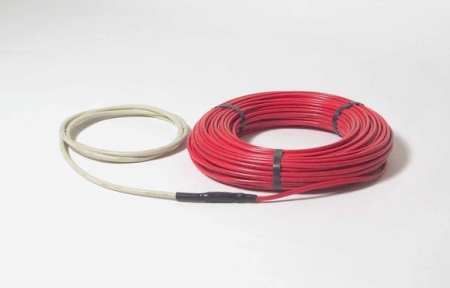
Infrared
The role of the heating element in this case is played by a thin insulating polymer film. It includes several modules, each of them consists of many strips, which directly carry out the heating of the floor, thanks to the supply of electricity.
The advantage of infrared flooring is that it is quite thin and consumes little electricity. In addition, it can be laid under almost any floor covering. For example, you can put such a warm floor under a tile on a wooden floor.
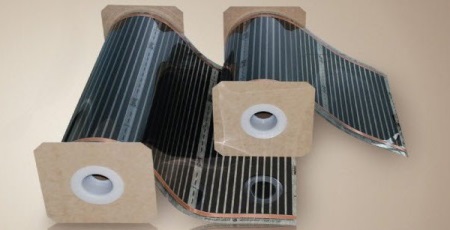
Water
The principle of operation of such a heater is quite simple: under the tile are laid metal-plastic pipes, in which hot water flows. The pipes can be connected to a central or autonomous heating system.
The cost of laying and operating such a warm floor is one of the cheapest, which is its great advantage. Unfortunately, such a system cannot be installed in many multi-storey old buildings, because they may not be able to withstand such a load.
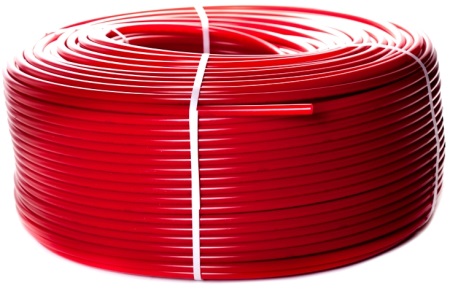
String flooring
Rod floor is similar to the infrared floor, but in this case, the heating element is not a special film, but rod mats. This system appeared relatively recently, but has already managed to prove its effectiveness, efficiency and reliability.
The rods themselves are made of a composite material, composed of graphite and silver. They are connected to each other with special tires, which conduct the current. Rod-based floor heating is not afraid of aggressive environmental influences and can serve not only as an auxiliary, but also as the main heating system.
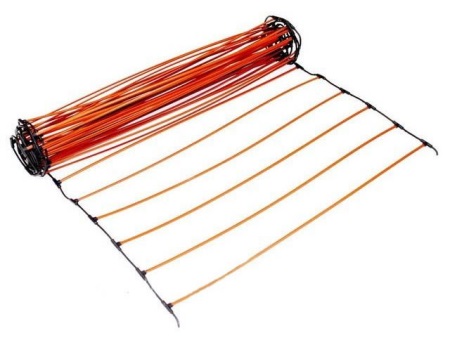
A set with a thermostat
The thermostat plays a very important role in the operation of the underfloor heating. It is responsible for its proper operation and enables you to save on your energy bill. That is, you can only turn the underfloor heating on and off when you need it.
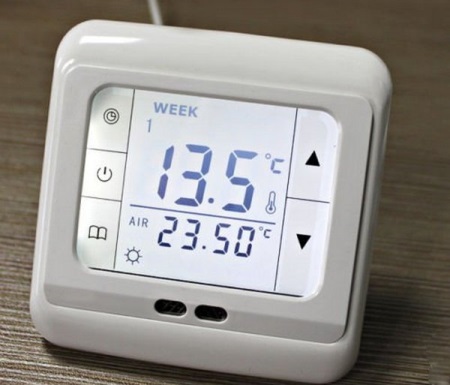
When choosing a thermostat, you need to pay attention to its maximum power. If you have a large heating area, the power limit should not be less than 3000W, and even better than that. Otherwise, the thermostat can simply burn out.
Programmable thermostats that can be set to automatically lower or raise the temperature are very popular today. Such a "smart" device, compared to the usual one, will save 50% more.
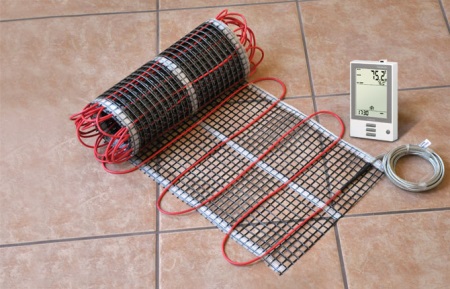
Companies and manufacturers
Devi
This Danish company was founded in the 1940s. Initially it specialized in the production of heating devices, but over time the range of the company began to expand. Today it is the only company that is exclusively engaged in the creation of cable heating systems.
The brand assortment is wide enough, so you can choose a heating system for almost any room, including protection against moisture and precipitation. New types of cable products and thermoregulators are constantly appearing, so you will have no problem with the purchase.
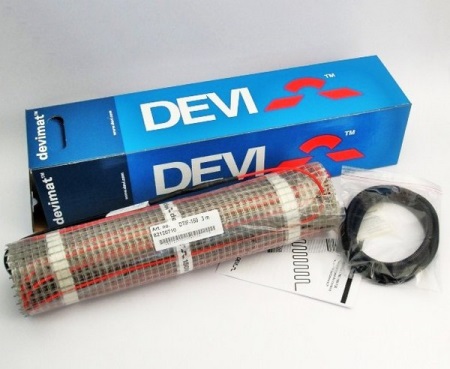
Teprolux
This company sells a variety of electric heating systems. One of the most popular is a unique mobile system "floor heating", which does not require installation, special tools for installation and special skills. After purchase, it is fully ready for use.
It is a solid fabric of artificial felt, on which the heating cable is evenly distributed. It is enough to place the system on the floor and plug it into the socket.
This system can function with any type of flooring, including wood, linoleum and laminate. Because it is compact and mobile, you can take it with you when you move.
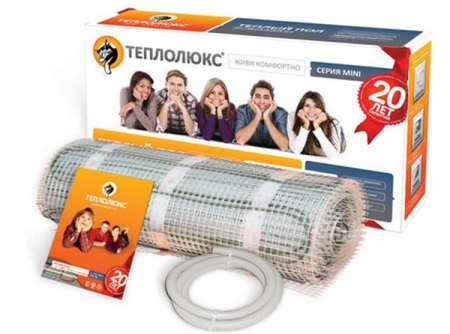
Thermo
The Swedish company specializes in the production of heating products. Thermo Industri's underfloor heating is an eclectic heating system that comes in two types. It can be presented as a cable or as a specially equipped mat.
To choose between these two systems, you need to understand what you want from this heating system. This depends on many factors, so you should definitely consult with a specialist before buying.
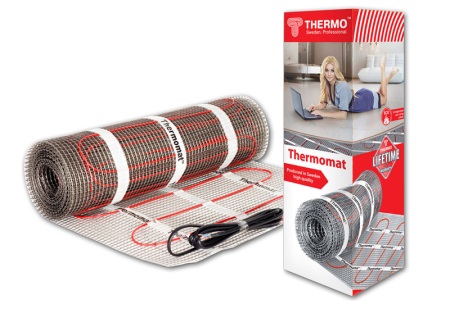
How to choose?
Under the PVC tile
Under the PVC tile, you can use any of the above "warm floor" systems.
Each has its own advantages and disadvantages.
- Water floor - this is not the best solution in this case. Its only advantage is that you will have reduced energy costs. However, the system has a low efficiency, it is difficult to install, there is a risk of water leakage and it is not recommended to install it in a multi-storey house.
- If you want to use infrared flooring, you will need not only to pour a concrete screed before installing it, but also put sheets of plywood on top. This system does not tolerate any unevenness. However, it is considered one of the best. Infrared flooring requires the lowest level of concrete screed, it has the highest level of efficiency, good thermal conductivity and almost no risk of breakage.
- Cable flooring also has its advantages. The main one is that it can be cut, which means it can be installed in rooms with complex layouts. However, cable flooring can't be laid under furniture and electrical appliances, and it doesn't have a very high level of efficiency. Most importantly, it must take at least 30 days after installation before you can start using the system.
- The rod floor is best combined with PVC tiles. You don't have to make a concrete screed to install it, a layer of tile adhesive is enough. In addition, it is a self-regulating system that shuts down when the maximum temperature is reached. You can place it all around the perimeter, without worrying about the location of furniture and appliances. The only disadvantage, as in the previous case, you will have to wait a month until the system can start using.
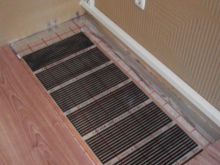
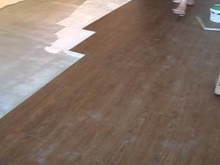
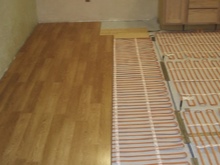
Quartz vinyl
Manufacturers claim that the use of warm floors under quartz-vinyl tile is not required, since the thermal conductivity of this material is commensurate with the thermal conductivity of wood flooring. But there are areas where a system of "warm floor" is needed, such as in the nursery, bathroom or kitchen.
In this case, you can use almost any system of underfloor heating. However, water, cable or infrared is recommended. Whichever system you choose, it should not exceed 28°C during operation.

Ceramic
You can use all types of underfloor heating under ceramic tiles, the most popular are water, electric and infrared. The advantages and disadvantages of each of them have been described above.
Making your choice, you need to consider many nuances. For example, whether you plan to use the floor heating as the main heating system, or auxiliary. Is there enough electric power in your apartment, if not, you may want to pay attention to the water floor. At the same time, it will not be possible to install it in an old apartment building. In general, when installing the ceramic tile itself, there are no restrictions, it is compatible with any heating systems.
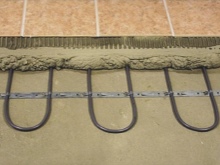

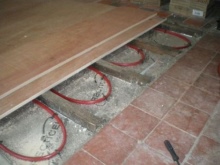
Tile glue
Since the layered construction of warm floors will be exposed to constant heat, it is important to use a special adhesive when installing the tiles. It will prevent the flooring from cracking and peeling during use.
Any floor tiles are laid on an even cement or polymer screed. Selecting glue for tiles, it is important to pay attention to what bases it can be applied, and whether the screed does not contain components that are not suitable for the glue.
Most often use an adhesive that is enriched with plasticizers. It should be marked M500. It is also possible to use adhesive on the basis of epoxy resin. Both options are good, because they are resistant to heat exposure.
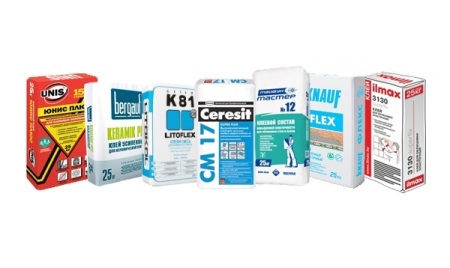
Floor thickness
Floor thickness, or more precisely, the thickness of the concrete screed is a very important nuance that should be taken into account when laying. Often the thickness of the concrete screed is calculated individually, as it depends on the height difference of the floor, the presence of depressions and other nuances.
There is a misconception that the thicker - the better, but this is not entirely true. It is determined by focusing on the highest point of the base, while the screed over the electric floor should not be less than 30-50 mm, and over water - 50-70mm.
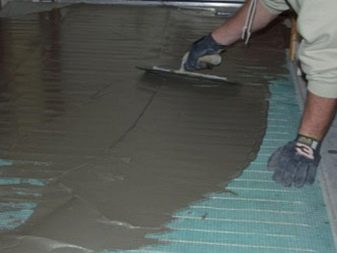

As for the living room, then the minimum thickness should be 70 mm. If you want the thickness was less, it is necessary to increase the strength of the screed, using a reinforcing mesh.
Arrangement of underfloor heating under the tiles
Regardless of which underfloor heating system you have chosen, the preparatory stage will be very similar.
Preparatory work
To begin with, you will need to perform the dismantling of the old flooring and remove all debris. If there are no defects on the floor, you can not do a rough screed, but if they are, you will need to make the floor leveling with concrete mortar.
If you have opted for an electrical system, you will need to make sure that the old wiring is strong enough. If necessary, the wiring will have to be replaced.
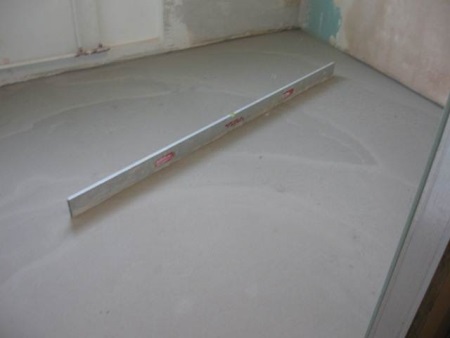
The process of thermal insulation
Before installing underfloor heating, the surface on which it will be laid will need to be insulated. This procedure will only contribute to the efficiency of the system and will help you to save significantly.
Most often used for this purpose is foam-foil - a material with a self-adhesive layer, which has a foil coating. It is glued to the concrete surface, and then the joints are glued with a special adhesive tape. Increase the level of insulation is possible by laying foil so that it is slightly over the walls. On top, a metal mesh is usually laid, which helps speed up the process of installing the heating system.

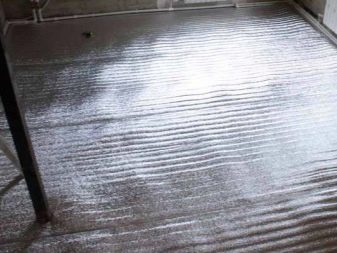
How to lay it correctly?
Cable
First you need to install a temperature controller, which is usually placed next to the outlets. The temperature sensor itself should be placed in the floor, placed in a special corrugation.
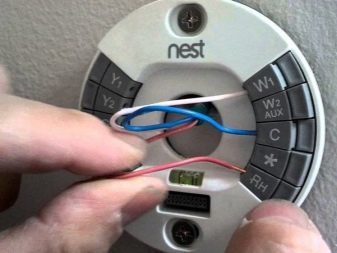
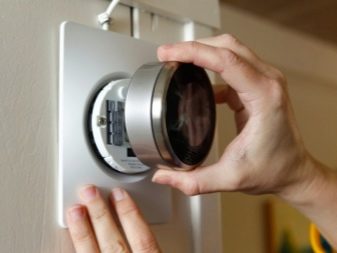
Now you can start laying the cable, securing it with mounting tape. You can come to the aid of handy flexible plastic clamps that make this process faster and easier. To ensure that the room is subsequently heated as evenly as possible, the distance between the coils should be about the same.
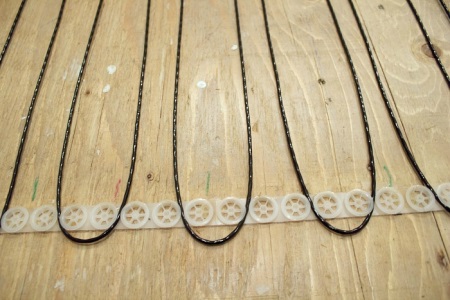
When you finish laying, do not forget to check whether the connection has been made correctly. To do this, you can use a special device - a multimeter.
Installation of the system with heating mats is carried out in the same way. However, the process of laying is slightly facilitated by the fact that the cable on the mats is already evenly placed, you will only have to place them on the perimeter.
After all the done manipulations, you can make a concrete screed, and, having waited for its complete drying, start laying the floor covering.
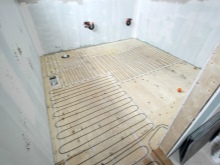
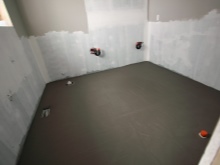
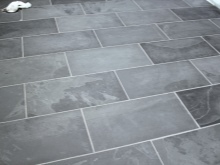
Water
When the concrete screed dries, you can start laying pipes, which will later be connected to the manifold of the heating system. It is not recommended to connect the floor heating to the central heating, because the water, which will pass through your heating system, will go to the lower floors in the cooled form. In this case, you can not avoid problems with the neighbors.
After you lay the insulation material, on top of it you will need to place a reinforcing mesh, to which you can attach the pipes. You can lay them in any direction, for example, it can be a spiral or double serpentine. As with electric underfloor heating, the pipes must not be laid under furniture and plumbing fixtures.
Fixing the pipes must be "sliding", otherwise deformation is possible during operation. Usually, special clamps are used for this purpose. After laying, they will need to be connected to the manifold-distributor and perform a high-pressure test, which exceeds the standard norm. If everything is in order, you can make a concrete pour and start laying tile flooring.
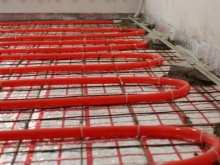
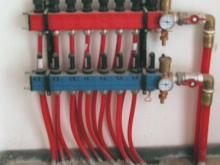
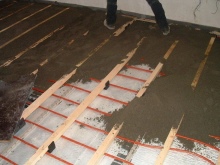
Tile laying
Concrete mortar will harden for 2-3 days, after this time it will be possible to start tiling the floor with, your chosen tiles. It is necessary to ensure that the surface was strictly horizontal, so at this stage it is better to ask for help from professionals.
In the very laying of tiles there is nothing complicated, it will need to be planted on a special adhesive, about which we wrote above. After you will need to wait until the glue dries, and the system itself can be put into working order. In the case of electric underfloor heating, you will need to wait about a month.
Thus, the installation of the underfloor heating can be considered over!
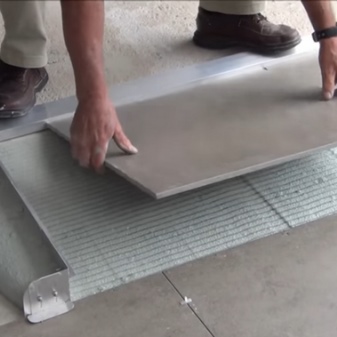

Reviews
Different reviews can be heard from the owners of the system "warm floor". They point out that if there is gas in the house, you can put a water floor, and if there is no central gas heating system, it is better to use an electric floor.
At the same time, the electric floor is less expensive, but the water floor is cheaper in operation. True, as has been said many times, you can not install a water floor in an apartment building.
Neighbors of water floor owners complain about flooding and cold radiators in their apartments. The expense of paying for your neighbor's repairs and possible fines is unlikely to give you much pleasure.
If you live in your own house, the problem with your neighbors disappears by itself. In this case, you can start with your own preferences. For example, you can't put furniture on an electric floor, and you can put it on a water floor. This is especially true in living rooms - a bedroom or children's room, where it may well be a rearrangement of furniture.
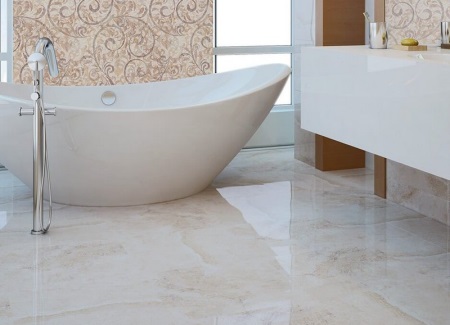
In general, the owners of the floor heating are satisfied with this system. If you make the right choice, you will enjoy it all the more. Owners of underfloor heating say that it is very pleasant to sit at the dining table and enjoy the warmth that comes from the underfloor heating. In the bathroom, it will also not be superfluous - even if the hot water is turned off, you will be warm and the floor will also always be dry.
Under-tile floor heating will provide you with comfort and coziness in the house during the cold season. In such a house you will want to hurry after work to enjoy the warmth of your home as soon as possible. Or more precisely, a warm floor!
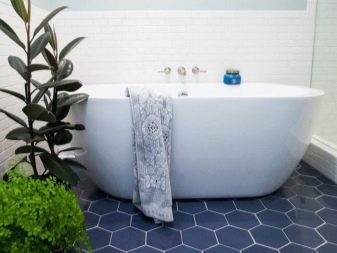

Learn more about installing a warm floor under a tile in the following video.




